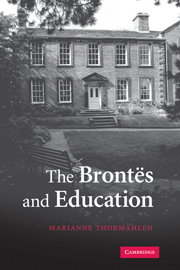IV - STRATEGIES AND METHODS
Published online by Cambridge University Press: 22 September 2009
Summary
Introductory Remarks to Section IV
The range of educational milieux in the Brontë novels is immense. Pupils of both sexes, all ages and very different social origins are instructed in all sorts of places – from the day nurseries of rich homes to the halls of large institutions of learning – by teachers of the most varied kinds. What these pupils and their real-life counterparts learnt was the topic of the preceding section; it remains to examine how they were taught. Looking at the Brontë works in the context of education in the early nineteenth century, how might successful educational activity be defined, what makes a teacher successful (or not) and in what ways can the fiction of the Brontës be seen to interact with the late-eighteenth-century and early-nineteenth-century pedagogical debate?
Before these questions can be answered, the ‘range’ concept should be contemplated from another perspective as well: that of quality. The difference between the best and the worst school in any system at any time is considerable. In the lifetime of the Brontës (as in our own), it was vast. The best-known novelists of the day left us a long list of appalling educational establishments, Dotheboys Hall and pre-reform Lowood Institute featuring at the top (or bottom, depending on how one looks at it). It has been suggested that the prevalence of horror schools in nineteenth-century fiction might be at least partly due to writers' knowing that it was ‘the done thing’ to be indignant about unsatisfactory education, even if one did not know a great deal about it.
- Type
- Chapter
- Information
- The Brontës and Education , pp. 151 - 154Publisher: Cambridge University PressPrint publication year: 2007



